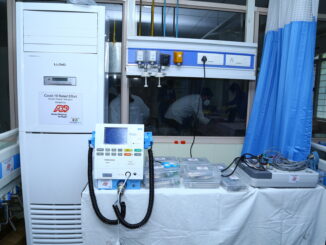
Leadership development has emerged as a key factor for organisations navigating through the COVID-19 global crisis, according to a new report by the Center for Creative Leadership (CCL) with global HR solutions provider, ADP.
As the global COVID-19 crisis challenges long-held assumptions about business models, workflows, technology and people, Chief Human Resources Officers (CHROs) across Asia-Pacific are being encouraged to challenge old myths and transform traditional leadership development if they are to survive and thrive in the post-COVID era.
Key findings from the report, Imagining Asia 2030: Future-Fluent Asian Leaders – Myths We Must Debunk, include:
● There is more to global leadership than cultural fluency: future Asian leaders are too often held back by factors such as organisational culture, hard-wired Asian culture, lack of mobility and lack of internal alignment to build the Asian talent pool.
● The must-have capabilities for Asian leaders to become global leaders are courage, curiosity, trust, influence and strategic thinking.
● Asian leaders typically fall into four types/categories: Asian returnee; regional champion; global nomad; or a local ex-pat.
● Three critical experiences stand out in preparing Asian leaders for global roles: cross-border rotation; non-obvious career moves; and taking on ‘stretch’ roles.
● Asian leaders are in demand to run businesses in the region and also inform the practices of global companies.
In the culmination of almost eight months of research, the report presents a comprehensive point-of-view on what the future of Asia may look like, particularly the critical megatrends that will shape the APAC region, their impact on societies, businesses, and, most importantly, how leaders must prepare today to succeed in the future.
The CCL identified five paradoxes HR must manage in order to drive a development agenda that is prepared for the challenges a post-COVID world may present. These include the need for ‘Asianised yet global’ leaders in organisations, balancing experiential with classroom-based learning and building personalised yet scalable development models.
The CCL also mapped the careers of successful global leaders, finding that many:
● were educated outside their home country
● had early leadership opportunities
● opted for secondments in a foreign country
● did a stint at their company’s headquarters (if outside Asia).
CCL Managing Director and Vice President, Asia-Pacific, Elisa Mallis, said leadership would be an essential ingredient in Asia’s growing global role over the years ahead.
“Prioritising good leadership will enable Asia to continue its rise on the global stage, providing solutions to the greatest challenges facing humanity.”
“Today more than ever before, organisations must enable their best people to act as guides as they navigate their way out of the current crisis. With humanity facing the greatest disruption of our lifetime, human resource and leadership functions are under extreme pressure not only to adapt to the here-and-now but to prepare their organisations for the post COVID recovery” Ms Mallis said.
Commenting on the importance of the research, ADP Vice President Strategy & Marketing APAC, John Antos, said it highlighted the complex realities of leadership development that CHROs must navigate.
“If business leaders want to become leaders of the 21st century, they will need tremendous agility to keep up with the pace of change. Huge uncertainties in the future mean leaders must have the ability to anticipate the future and work back toward the near term,” Mr Antos said.
“One of the most interesting insights to emerge from the research was the push to open up leadership development within Asian organisations in order to foster multilevel leadership development,” Mr Antos said.
He pointed to the finding that two in five leaders surveyed felt that one of the biggest misconceptions about leadership development is that only the senior leadership should play a ‘strategic’ role. Frontline managers, by contrast, make up or influence 80% of the workforce yet receive only about one-fourth of leadership development effort.
Mr Antos said the decision to sponsor CCL on the research reflected ADP’s global commitment to empower customers to continually innovate and shape the future world of work.
“This is the second in a series of research projects with the CCL. The partnership allows ADP to gain greater insights into the critical challenges and opportunities facing our clients and HR leaders across the region.
Five conclusions identified to shape the future of leadership in APAC:
1. Future fluency is about getting ahead of the curve
Bringing together the right mindset and capabilities, supported by context-relevant business and operating models which are reviewed and revised constantly will enable future-fluent leaders to think, learn, feel and act differently.
2. There are eight megatrends that will impact Asia differently to the rest of the world
The exponential advancement in technology, Rise of Asia, changing demographics, rapid urbanisation, deteriorating sustainability, rising economic inequality, evolving future of work, and increasing protectionism and populism has been identified as the major drivers of change in Asia. While each trend is distinct, they are connected with each other in many and often complex ways. To be successful in the next two decades and beyond, organisations and leaders must track these critical megatrends and respond accordingly. The deep, long-term, and far-reaching impact not only on businesses but on people, in general, will create opportunities for businesses and springing up challenges.
3. Six mindset shifts to manage the megatrends
Future-fluent leaders will need to change the way they think about solving problems in Asia and build capabilities to deal with uncertainties that megatrends will present. Asian leaders not only need to think differently, but also need to build appropriate capabilities to be future-fluent. Critical capabilities such as learning agility, collaboration and resilience will be must-haves to prepare leaders for whatever future Asia throws at them.
The core mindset shifts identified in the research are the changes: from “disruption anxious” to “disruption embracing”; from “doing what I can” to “doing what I should”; from “solo growth” to “collective development”; from “investing in known-unknowns” to “taking risks on unknown-unknowns”; from “looking forward” to “looking back (from the future)”; and from “looking west” to “looking east” for solutions.
4. Future-ready skills and capabilities
The research found that regardless of how things have been done over the last 20-30-50 years, future-fluent Asian leaders will need capabilities to “act” differently, to “learn” differently and to “feel” differently. Nine critical capability clusters emerged from the research including continuous learning; personal accountability; intellectual honesty; embracing contradictions; agility; ecosystem thinking; anticipation; empathy; and comfort with discomfort.
5. Diverse experience is key
Business-as-usual experiences will not prepare leaders for radical shifts in the Asian context. The best way to prepare a future Asian leader is to get as diverse a set of experiences as possible under their belt. Diverse teams will enable Asian leaders to be exposed to different possibilities, and look at the same scenarios through different lenses. By spending time working across different industries, future-fluent Asian leaders will be able to apply the learning from different industrial clusters or sectors to propel their businesses forward.



